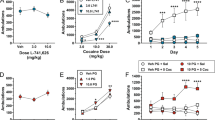Summary
The present study has shown that a subthreshold dose of the uncompetitive N-methyl-D-aspartate (NMDA) antagonist MK-801, combined with a subthreshold dose of LSD, produces marked locomotor stimulation in monoamine-depleted mice. Likewise, MK-801, as well as the muscarine receptor antagonist atropine and the α-adrenoceptor agonist clonidine, were found to interact synergistically with the putative 5-HT2 receptor agonist UH-232 to produce locomotor activation in monoamine-depleted mice. All these responses were effectively blocked by the highly selective 5-HT2a receptor antagonist MDL 100,907. On the other hand, MDL 100,907 did not antagonize the hyperactivity response produced by clonidine given in combination with MK-801 or atropine in monoamine-depleted mice, nor the response produced by the mixed DA receptor agonist apomorphine, underlining the selectivity in the antagonistic action of MDL 100,907. Furthermore, MDL 100,907 attenuated the hyperactivity produced in intact mice by such disparate agents as MK-801, atropine or the DA uptake inhibitor GBR 12 909. A putative “permissive” role of the 5-HT2 receptor in the context of psychomotor activation is discussed, as well as its possible importance as target for antipsychotic therapy.
Similar content being viewed by others
References
Angrist B (1987) Pharmacological models of schizophrenia. In: Henn FA, DeLisi LE (eds) Handbook of schizophrenia, vol 2. Neurochemistry and neuropharmacology of schizophrenia. Elsevier Science Publishers BV, Amsterdam, pp 391–424
Anis NA, Berry SC, Burton NR, Lodge D (1983) The dissociative anaesthetics ketamine and phencyclidine selectively reduce excitation of central mammalian neurons by N-methyl-D-aspartate. Br J Pharmacol 79: 565–575
Bischoff S, Heinrich M, Sonntag JM, Krauss J (1986) The D-1 dopamine receptor antagonist SCH 23390 also interacts potently with brain serotonin (5-HT2) receptors. Eur J Pharmacol 129: 367–370
Carlsson M, Carlsson A (1990) Interactions between glutamatergic and monoaminergic systems within the basal ganglia — implications for schizophrenia and Parkinson's disease. Trends Neurol Sci 13: 272–276
Carlsson M, Svensson A (1990) The non-competitive NMDA antagonists MK-801 and PCP, as well as the competitive NMDA antagonist SDZ EAA494 (D-CPPene), interact synergistically with clonidine to promote locomotion in monoamine-depleted mice. Life Sci 47: 1729–1736
Carlsson M, Svensson A, Carlsson A (1991) Synergistic interactions between muscarinic antagonists, adrenergic agonists and NMDA antagonists with respect to locomotor stimulatory effects in monoamine-depleted mice. Naunyn Schmiedebergs Arch Pharmacol 343: 568–573
Hyttel J, Larsen J-J, Christensen AV, Arnt J (1985) Receptor-binding profiles of neuroleptics. In: Casey DE, Chase TN, Christensen AV, Gerlach J (eds) Dyskinesia — research and treatment. Springer, Berlin Heidelberg New York Tokyo, pp 9–18
Javitt DC (1987) Negative schizophrenic symptomatology and the PCP (phencyclidine) model of schizophrenia. Hillside J Clin Psych 9: 12–33
Kay SR (1991) Positive and negative syndromes in schizophrenia. Brunner/Mazel, New York, pp 161–178
Kehne JH, Ketteler HJ (1993) Effects of the selective 5-HT2 antagonist MDL 100,907 on stimulant-enhanced locomotion in rats. Soc Neurosci Abstr 19, 666.13
Kim JS, Kornhuber HH, Schmid-Burgk W, Holzmüller B (1980) Low cerebrospinal fluid glutamate in schizophrenic patients and a new hypothesis on schizophrenia. Neurosci Lett 20: 379–382
Meltzer HY (1992) The mechanism of action of clozapine in relation to its clinical advantages. In: Meltzer HY (ed) Novel antipsychotic drugs. Raven Press, New York, pp 1–13
Schmidt CJ, Fadayel GM, Sullivan CK, Taylor VL (1992) 5-HT2 receptors exert a state dependent regulation of dopaminergic function: studies with MDL 100,907 and the amphetamine analogue, 3,4-methylenedioxy-methamphetamine (MDMA). Eur J Pharmacol 223: 65–74
Svensson K (1986) Dopamine autoreceptor antagonists. A new class of central stimulants. Thesis, University of Göteborg
Svensson A, Carlsson M, Carlsson A (1991) Synergistic interactions between the NMDA antagonist dizocilpine and the preferential dopamine autoreceptor antagonists (+)-AJ 76 and (+)-UH 232 with regard to locomotor stimulation in monoamine-depleted mice. J Neural Transm 85: 69–77
Svensson A, Carlsson A, Carlsson ML (1992) Differential locomotor interactions between dopamine D1/D2 receptor agonists and the NMDA antagonist dizocilpine in monoamine-depleted mice. J Neural Transm [Gen Sect] 90: 199–217
Tandon R, Shipley JE, Greden JF, Mann NA, Eisner WH, Goodson J (1991) Muscarinic cholinergic hyperactivity in schizophrenia. Relationship to positive and negative symptoms. Schizophr Res 4: 23–30
Author information
Authors and Affiliations
Rights and permissions
About this article
Cite this article
Carlsson, M.L. The selective 5-HT2a receptor antagonist MDL 100,907 counteracts the psychomotor stimulation ensuing manipulations with monoaminergic, glutamatergic or muscarinic neurotransmission in the mouse — implications for psychosis. J. Neural Transmission 100, 225–237 (1995). https://doi.org/10.1007/BF01276460
Received:
Accepted:
Issue Date:
DOI: https://doi.org/10.1007/BF01276460




